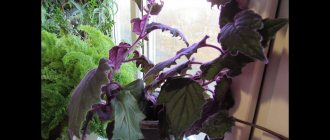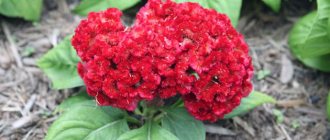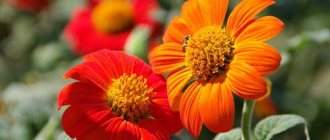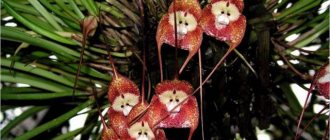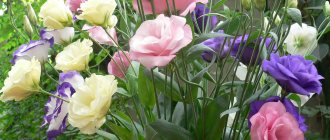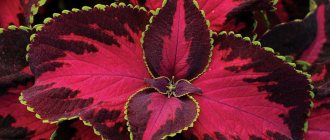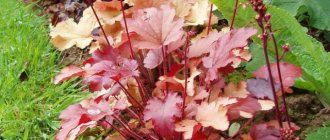Author: Natalya Category: Garden plants Published: February 02, 2019Republished: February 02, 2019Last edits: November 03, 2020
- When to plant
- Growing conditions
- How and when to collect seeds
- Celosia silver comb
plant (lat. Celosia) , or cellosia , is a genus of the Amaranthaceae family, although not so long ago it was classified as a member of the Chenopodiaceae family. The name of the plant comes from the Greek kelos, which means “flaming, burning” and characterizes the color and shape of the inflorescences, similar to multi-colored flames. In nature, celosia flowers grow in warm regions of Africa, Asia and the Americas; about 60 species of them are known today, but in garden culture, celosia comb, celosia pinnate, and celosia spicata are most often grown.
Planting and caring for celosia
- Planting: sowing seeds for seedlings at the end of March or early April, planting seedlings in open ground - in the second half of May.
- Flowering: from July until frost.
- Lighting: bright sunlight.
- Soil: fertile, well-drained soils of neutral reaction.
- Watering: moderate, only during drought.
- Feeding: once a month with complete mineral fertilizer. Before budding begins, you can also use organic matter, but only rotted ones.
- Reproduction: seed.
- Pests: aphids.
- Diseases: chlorosis, during the seedling period - blackleg.
Read more about growing celosia below.
Botanical description
The celosia flower is represented by both annual and perennial species, there are also shrubs among them, but in cold winters celosia is grown as an annual plant, since it does not tolerate sub-zero temperatures. The stems of celosia are straight and branched, the leaves are alternate, ovate, ovate-lanceolate or linear-lanceolate. Small flowers are collected in spike-shaped, comb-like or paniculate inflorescences of different shades - yellow, pink, red, orange, scarlet and golden. The fruit is a polyspermous capsule.
Growing celosia from seeds
Sowing seedlings
Readers often ask to know how to grow celosia from seeds, since this is practically the only way to propagate it. But before sowing, the seed must be kept for 3-4 hours in a solution of Epin and Zircon (a drop of each drug per glass of water) in order to soak the too dense seed coat. Sowing is carried out in March or early April in bowls on the surface of the soil, consisting in equal parts of humus soil and vermiculite. Sow not thickly, and there is no need to sprinkle the seeds, just press them tightly to the ground and sprinkle with water from a spray bottle.
The container with the crops is covered with film or glass and kept on a bright windowsill at a temperature of 23-25 ºC, protected from direct sunlight and occasionally ventilated, moistened and removed condensation. If you don’t want to bother with picking, sow celosia seeds directly into individual pots. Shoots begin to appear within eight days.
- Planting flowers for seedlings in April
Seedling care
Growing celosia seedlings involves organizing additional illumination for seedlings for 4-6 hours, since at this time of year the daylight hours are still too short. In the case of group sowing of seeds, seedlings have to be planted twice. The first time - when the seedlings have 2-3 leaves - they are planted in the same substrate in a container 4-5 cm deep at a distance of five centimeters from each other.
When the seedlings take root after picking, they are fed simultaneously with watering with a weak solution of complex mineral fertilizer for flowering plants. When the plants become stronger, they are dropped into a deeper cassette or, using a scoop, removed from the container along with a lump of earth and transplanted into individual pots (preferably peat-humus). As soon as you are sure that the plant has taken root, you can carry out a second feeding of the same kind.
Possible problems in growing
The list of factors threatening the health of a flower includes such standard factors as infections, parasites and poor conditions.
Chlorosis on celosia
Pests
Most of all, aphids love to feast on celosia, as they can quickly absorb a significant area of the flower. Among the products used to protect plants, the most popular are “Aktara”, “Aktellik”, “Inta-Vir”, “Iskra Bio” and “Fitoverm”. A simple solution consisting of 2 tsp is also effective. liquid soap, 2 tbsp. water and 1 tbsp. l. vegetable oil passed through cheesecloth.
Additional Information! The plant is treated in the evenings every 3 days.
Diseases
The most dangerous ailment of celosia is considered to be black leg, which is usually a consequence of waterlogging or watering on cloudy or cool days. It can be prevented by frequent loosening of the soil near the bushes. The areas of the plant affected by the disease are treated with antifungal agents such as “Skor”, “Strobi”, “Brunka” and “Topaz”. With this disease, the soil near the stem is loosened and mixed with ash, and watering is temporarily stopped. Sometimes replanting can help, but in advanced cases the plant is destroyed.
High acidity of the soil can cause chlorosis, which can be treated with products containing iron compounds.
Signs of improper care
The following symptoms may indicate a diseased state of the plant:
- withering;
- the dominance of insects under the leaves;
- blackening of the stem;
- curled foliage;
- yellow spots on the leaves or their blanching;
- thinning of the stem.
Celosia (annual or perennial) is a common decoration for flower beds, borders, borders, hedges and a good solution for landscape design. With its help you can create all sorts of colorful compositions. This lush flower is also used for bouquets with no less success. Low decorative varieties are suitable for decorating balconies and verandas. Celosia is unpretentious, but very delicate, so it should be properly cared for. Despite the heat-loving plant, it feels good in the middle zone during warm seasons. In the south, herbaceous bushes of the genus Celosia can also be grown as perennial flowers.
Planting celosia
When to plant
The time to plant seedlings in open ground comes when the warmth has finally set in and the threat of night frosts has passed - in the second half or at the end of May. Choose a site for the plant that is sunny, protected from the wind and well drained. If the soil in the area is acidic, lime it before planting celosia. But do not add fresh organic matter to the soil for celosia - the plant does not tolerate it.
How to plant
Celosia is planted in the usual way for garden plants. Young celosia grown from seeds is still very fragile, so try not to damage its root system when transplanting and use the transshipment method. If you picked or sowed it in peat-humus pots, then plant celosia in the ground directly with them. It should only be taken into account that low-growing species and varieties of plants are planted with a gap of 15-20 cm between specimens, and tall ones - at a distance of 25-30 cm from each other.
Popular varieties of celosia
Among the most popular celosia varieties among flower growers, the most common ones should be noted. And we also need to tell you more about them.
Pampas Plume
This compact, pyramidal-shaped plant features paniculate inflorescences that are larger than other varieties with similar flower shapes. Pampas Plum is very thermophilic and light-loving; this should be kept in mind when choosing a place to plant it. It is valued by gardeners for the original beauty of its inflorescences and highly decorative foliage.
Kimono
These are superminiature bushes, the height of which does not exceed 14-15 cm. The inflorescences are densely double, paniculate in shape. Their color can be red, burgundy, orange, yellow or cream. Flowering of the Kimono variety begins in early July, and the last flowers appear at the end of September.
The plant is thermophilic , so it blooms well in sunny places protected from drafts and wind, and the soil must be fertile. This variety is used in group plantings and for growing in compositions in flower beds.
Celosia Kimono
Peacock
This annual is of medium height (stems grow up to 0.5-0.6 m in height), the shoots are ribbed, succulent, the foliage is bright emerald.
The inflorescences are paniculate in shape, the color of the flowers ranges from orange and yellow to red. It is better to grow in open ground in well-lit areas that are protected from gusts of cold wind. And the soil in the flower beds should be well fertilized. Flowering time is from early July until the first frost.
Cherry coral
This variety belongs to the comb varieties of celosia. Comb inflorescences bloom in mid-summer and bloom almost until the cold weather. The shades of flowers are juicy and bright, which is why Cherry Coral is used to decorate flower beds and ridges.
Celosia Cherry Coral
Empress
These flowers have erect, thick shoots that can reach a height of up to 0.48-0.5 m. The inflorescences are comb-shaped, quite dense, and the color is dark red. The foliage is dark emerald. The first buds appear in the first ten days of July , and the last ones begin to fade with the onset of cold weather.
Celosia Goldfeder
Goldfeder
These low-growing bushes attract attention with beautiful bright panicles-inflorescences of a golden hue. They are planted in flower beds and striped lawns. Flowering occurs from early June to early October. The flowers stay on the bushes for quite a long time.
Tomsoni Magnifica
This variety of pinnate celosia has an unusual color of foliage and stems - pink with a green tint, inflorescences are pyramidal in shape, and the color of the flowers is burgundy. Looks impressive in group plantings and flower beds. Inflorescences have effects in dry bouquets, where they can remain all winter.
Celosia care
Growing conditions
Growing and caring for celosia in the garden is not particularly difficult, but you should know its two weak points: celosia grown from seeds at home in open ground can die even from light frosts, and in addition, it does not tolerate too wet soil . Based on these features, organize care for celosia. So, you need to water celosia only on the hottest days, if it has dropped its leaves and stopped forming flower stalks.
But do not neglect monthly fertilizing, which celosia accepts very favorably, but do not get carried away with nitrogen fertilizers, otherwise you will get lush foliage, but will not see flowering. Loosen the soil around the plants, remove weeds - that’s all the wisdom.
- Sweet tobacco: growing from seeds, planting and care
Pests and diseases
At the “tender seedling age”, celosia is affected by black leg due to excessive humidity. As soon as you discover the disease (blackening of the stem at the base), loosen the soil, sprinkle it with a thin layer of wood ash and stop watering for a while. Sometimes aphids settle on the plant, which can be controlled by spraying celosia with the following composition: 2 teaspoons of liquid soap, a glass of vegetable oil and two glasses of water. The treatment must be done several times every few days in the evenings. Celosia is resistant to all other insects and diseases.
How to determine the time of sowing celosia seedlings?
Sowing time largely depends on the region of residence; the approximate general time frame for planting indoors is the end of March - the beginning of April.
It is important that the celosia does not fall under frost. If you sow directly into open ground, the timing will shift until the end of April - beginning of May. In this case, the crops must be covered with film. Germination and flowering will occur later.
Celosia is a delicate plant, so the soil needs to be fertile, loose, with an acidity of up to pH 6.2 (or neutral). You can use a universal soil mixture.
It remains to determine what kind of celosia we will plant.
Lunar calendar for 2020
The temperature under the film should be about 23 degrees. Avoid direct sunlight - it is better to cover the containers with paper. Be sure to ventilate daily for about 1.5 hours. When the soil dries out, moisten it with water using a spray bottle.
Sprouts appear after about 10 days. Remove the paper and place the container in partial shade: it is better to prevent direct sunlight from reaching the sprouts. Don't forget to spray the soil (but without fanaticism!).
Dive rules
It is customary to dive celosia 2 times:
- When the first leaves appear on the sprouts, it is necessary to give them free rein and transplant them into a spacious box(s) at a distance of 5 cm.
- Upon reaching 10-15 cm, seedlings from a common box must be sorted into separate pots/glasses.
14 days after diving, you can add a complex of mineral fertilizers for flowers. Peat pots do not require fertilizing.
Wait a while before transplanting into open ground; first you need to select and prepare it.
The place should be sheltered from the wind and sunny.
- A week before planting, we dig up (mix heavy soil with sand) and add humus.
- 1-2 days before planting, treat the soil with a solution of potassium permanganate for disinfection.
You can send celosia to the mainland only after all the frosts have passed: the plant is too fragile and will not withstand even minor cold snaps. More precise dates depend on the region and expected temperatures in a particular year, but on average it is no earlier than May 15th.
You should not rush to plant grown strong seedlings in open ground - you should wait until the spring frosts have passed, and only then place the young plants in a permanent place in the flower garden. Typically, in most regions, the time for planting celosia seedlings is the second or third ten days of May.
The place for planting seedlings should be sunny, protected from the wind, and the beds should have drainage. A place where groundwater comes too close to the surface of the earth is absolutely unsuitable for planting these flowers.
The soil should have a neutral or slightly alkaline reaction; in acidic soils, lime or chalk should be added before planting. Fresh organic matter cannot be added before planting these flowers, because these flowers do not tolerate it.
The distance between miniature varieties in a row should be at least 18-20 cm, and between tall specimens - about 30 cm.
It is better to transplant seedlings into planting holes using the transshipment method so that the plant can better withstand the adaptation process in a new place
There are practically no special difficulties in further caring for seedlings. You just need to remember some of the weaknesses of these flowers:
- seedlings can die in open ground even from a slight cold snap;
- Don't water these plants too much.
Based on this, the basic care for celosia is based.
Therefore, all varieties of these beauties should be watered only in hot weather if gardeners notice that the plant has dropped its foliage and practically does not form flower stalks.
Feeding celosia
Once every 30 days you should feed the flowers with complex mineral fertilizers. But if at the end of May - beginning of June their composition should include nitrogen in addition to phosphorus and potassium (which will contribute to the rapid growth of the vegetative mass), then from the end of June this mineral element should be excluded from the composition of the fertilizing.
After watering and fertilizing, you should loosen the soil under the bushes and remove weeds.
No other care is required for these flowers.
Once every 30 days, celosia should be fed with complex mineral fertilizers.
When seedlings are still growing indoors, due to excessive watering they may be affected by blackleg. The sooner this disease is noticed, the greater the likelihood of saving the future flower garden from death. The main symptom of the disease is blackening of the stem at the surface of the ground. You should carefully loosen the soil and sprinkle it with a thin layer of wood ash. Watering should be temporarily suspended.
We invite you to familiarize yourself with Apple marshmallow recipes: simple and very simple
Plants are often attacked by aphids. It can be easily dealt with using a simple folk remedy: spraying the plants with a liquid soap solution. To do this, dilute a dessert spoon of liquid soap and 200 ml of vegetable oil in 400 ml of water. This treatment is carried out several times every two to three days (preferably in the evening).
But this plant is resistant to all other diseases and “harmful” bugs.
Indoor celosia - not too capricious indoor flower
In most regions of our country, this flower is grown as an annual, so after collecting the seeds, all plants are torn out of the soil and burned in order to plant new specimens in this place the next season.
Once every 10-14 days, the flower is fed with mineral fertilizers (without nitrogen!).
Yellowed foliage is removed, and fading buds are also removed. Most often, celosia is thrown away after flowering, but many gardeners grow it as an ornamental perennial.
These flowers look beautiful in the garden, and thanks to the variety of varieties and a fairly long flowering period, celosia can be a wonderful decoration for any area.
Attention, TODAY only!
Celosia after flowering
How and when to collect seeds
To collect celosia seeds, cut off several fading inflorescences and place them in a dark room in a vase without water. When the bouquet is dry, shake it over the newspaper, and blow what is poured out and put it in a storage box. You can not keep the branches in a vase, but hang them with their inflorescences down and lay newspaper under them, onto which ripe seeds will spill out of the dried bolls.
Celosia in winter
Usually, after flowering, celosia is destroyed in order to plant new specimens next spring. But celosia is an ideal plant for dry bouquets: cut, remove leaves and bring into the house some of the most beautiful flowering branches of a tall variety, tie them into a bunch and let them dry in a dark room with good ventilation, and then put them in an empty vase so that they decorated your home in the middle of winter with their bright, beautiful flames.
Transfer to open ground
Celosia seedlings are planted in a permanent place using the transshipment method along with a lump of soil in which the plants grew. You can replant starting from the second ten days of May, when there are no more frosts.
You may also be interested in: 20 popular varieties and types of perennial iris flowers
The place for planting seedlings should be well-lit and protected from wind and drafts. The soil must be drained and not acidic; if necessary, it should be limed before planting. It is not recommended to add fresh organic fertilizers to the soil, since celosia does not tolerate them.
When growing low-growing varieties, the step between planting holes should be about 15 cm, in the case of tall varieties, at least 30-35 cm.
Types and varieties
We invite you to familiarize yourself with the most popular species, varieties and varieties of celosia in garden culture. The favorite of our gardens is silver celosia, presented in two varieties:
Celosia silver comb
Or “cockscomb” (Celosia argentea f. cristata) - a plant 45 cm in height, but there are smaller varieties. The leaves are green, burgundy, bronze or golden, depending on the variety. Small flowers are collected in a massive inflorescence, shaped like a cockscomb in purple-red or orange shades. Blooms from mid-summer to October. Varieties:
- Impress - height 20-25 cm, red inflorescence, dark red leaves;
- Atropurpurea - the same height, the stem is pinkish, the leaves are light green, the inflorescences are purple;
- Imperialis is a short variety with dark red shoots, purple leaves with red veins and dark red inflorescences;
Celosia silvery pinnate
It is also panicled celosia (Celosia argentea f. plumosa) - a variety that sometimes reaches a height of 1 meter, but has stunted and even dwarf varieties. The straight stems end in large panicles of yellow, orange and all shades of red. The leaves are juicy green, light green, pink or red, depending on the variety. Blooms from July to October. Varieties:
- Goldfeder is a low-growing variety with golden inflorescences;
- Tomsoni Magnifica is a tall variety up to 80 cm tall with burgundy inflorescences against a background of light green leaves;
- Torchshain is a tall variety with bright red panicles;
- New Onion - 35-40 cm high, leaves are purple-violet, inflorescences are yellow-orange.
Celosia spicata
Or Hutton's celosia (Celosia spicata) has not yet taken root in our gardens, but interest in it has grown noticeably in recent years. Its height is from 20 to 120 cm, and the small, spikelet-like paniculate inflorescences, in addition to red, yellow and orange shades, are also painted white. And the coral spikelet celosia will not leave anyone indifferent!
- Pruning hydrangea tree
Decorative types of celosia
The most famous variety of decorative celosia is silver celosia, which includes paniculate and pinnate types of these flowers.
Celosia pinnate (paniculate)
This variety of celosia can reach 0.9-1.0 m in height, but there are also miniature varieties. The foliage of this species can be bright emerald, pink or scarlet. And the color of small flowers can vary from orange to various shades of red.
Celosia pinnate (paniculate)
Celosia comb (cockscomb)
This flower is known among gardeners as “cockscomb”. The height of the peduncle can reach 0.5 m, but smaller specimens are also found. The color of foliage in different species can be emerald, dark red, golden or bronze in tone. The inflorescences are bright scarlet in color, and in shape they are simply comb flowers.
Celosia comb (cockscomb)
Celosia spica
This spectacular, magnificently decorative beauty compares favorably with its “brothers”, so it will look great in a flowerbed among other flowers. Its stems are straight, often grow together, very strong, and can grow up to 0.7-0.8 m in height. A beautiful fluffy pink tuft grows on each top of the stem. Panicles retain their decorative effect for a long time, not only in flower beds, but also in dry bouquets (in this case they can stand in a vase all winter).

